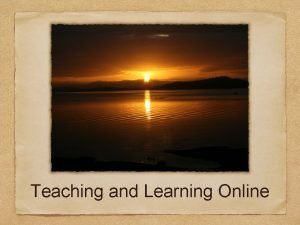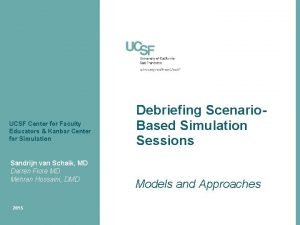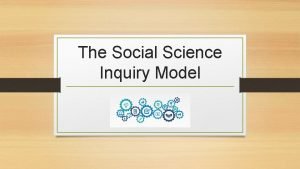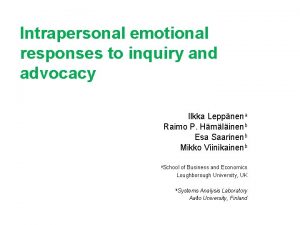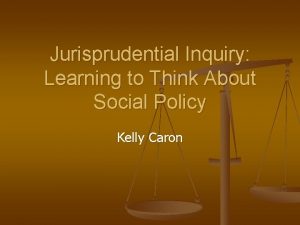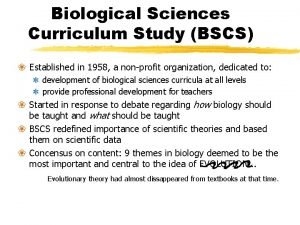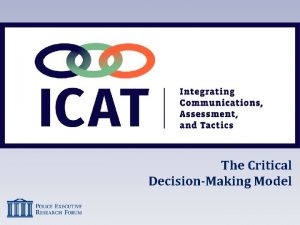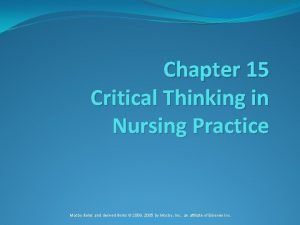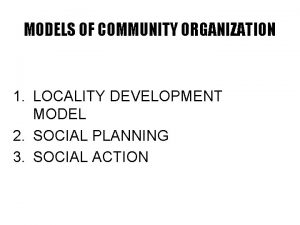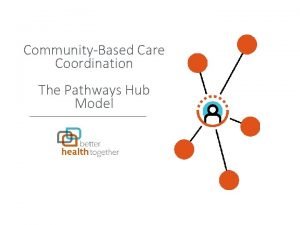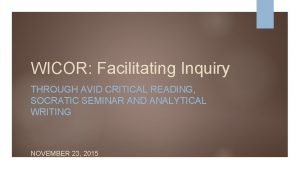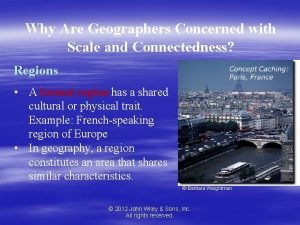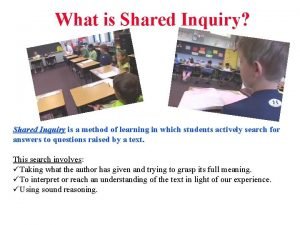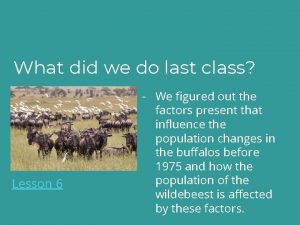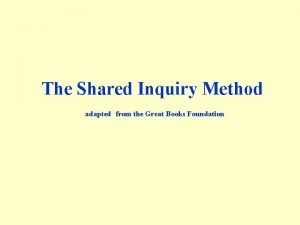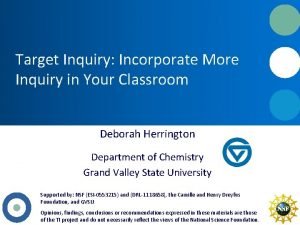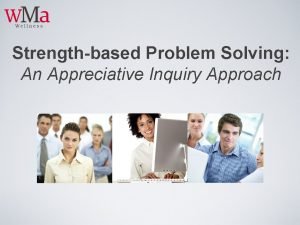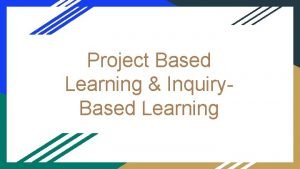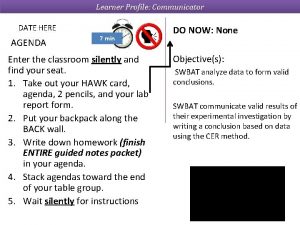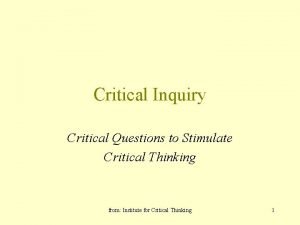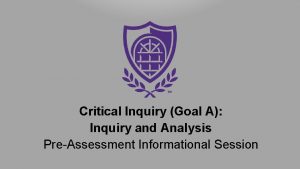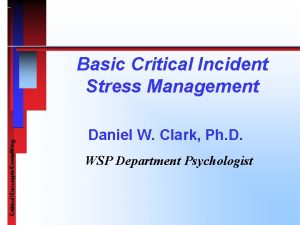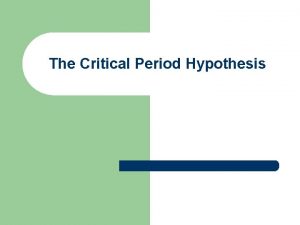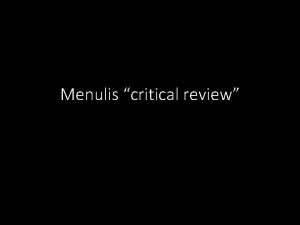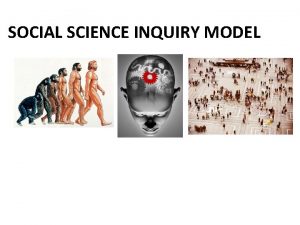Community of Inquiry Model Critical Inquiry in a















































- Slides: 47

Community of Inquiry Model Critical Inquiry in a Text-Based Environment: Computer Conferencing in Higher Education Garrison, D. R. , Anderson, T. & Archer, W The Internet and Higher Education 2, (2 -3), 1999, 87 -105 935 Citations Ph. D Seminar – Terry Anderson Nova University Lisbon, 2011

Some Slides from Cider session 2008 Community of Inquiry Framework: Validation & Instrument Development Arbaugh, J. B. Cleveland-Innes, M. Diaz, S. Garrison, D. R. Ice, P. Richardson, J Shea, P. Swan, K. Canadian Institute of Distance Education Research 2 -29 -2008

Expectations of Theory • Create conceptual order and provide simplicity (parsimony) in describing and predicting complex phenomena. “Science is a way of ordering events. ” • J. Bronowski, Common Sense of Science, 1978 • Predicative as opposed to descriptive? ? • Aide practice? • Is a Heuristic a Theory?

Tests pilots Interventions Trials

Tests pilots Variable 4 Interventions Variable 2 Trials Variable 1 Variable 3 Contexts

Model Tests pilots Variable 44 Interventions Variable 22 Trials Variable 11 Variable 33 Contexts

THEORY Variable 4 Variable 2 Variable 1 Variable 3

Motivations for the Community of Inquiry Investigation (1998) • CMC most widely used tool for interaction in online DE • Need for a bird’s-eye view of the overall learning taking place, and to respond to that learning, assess it, or intervene. • CMC Hype & lack of empirical validation of claims • Need for heuristic guides for both teachers and learners • Finding the optimal reward levels for participation • Desire to exploit affordances: – – – Machine readable Time independent Power of text Reflective Knowledge hidden in the transcripts Need for teacher usable tools to assess interventions

Community • … community means meaningful association, association based on common interest and endeavor. The essence of community is communication, … >>John Dewey

University • The word university is derived from the Latin universitas magistrorum et scholarium, roughly meaning "community of masters and scholars”.

Inquiry • Is problem or question driven • Typically has a small-group feature • Includes critical discourse • Is frequently multi-disciplinary • Incorporates research methods such as information gathering and synthesis of ideas”

Community of Inquiry • The importance of a community of inquiry is that, while the objective of critical reflection is intellectual autonomy, in reality, critical reflection is “thoroughly social and communal”. >>Lipman, 1991


Cognitive Presence Dr. Phil Ice University of North Carolina Charlotte Dr. Randy Garrison University of Calgary

Foundations • Cognitive presence is defined as the exploration, construction, resolution and confirmation of understanding through collaboration and reflection in a community of inquiry. (Garrison, 2007)

Practical Inquiry Model (Adapted from Garrison & Archer, 2000)

Theoretical Basis • Dependent upon a curriculum grounded in richness, recursion, relations and rigor (Doll, 1993) • Learners achieve resolution through iteration and conversation (Doll, Fleener, Trueit & St. Julien, 2005)

Teaching Presence • The transcript analysis allows researcher to disaggregate the roles – Instructional designer and activity organizer – Discourse facilitator – Subject matter expert • Especially critical in computer conferencing (asynch text) based education systems • Major cause of course breakdown.





• “Our research has demonstrated that teaching presence is important to student satisfaction, student knowledge and learning context. Students who were dissatisfied indicated that teaching presence was low. Therefore, faculty need to do more to improve teaching presence. ” – THE IMPORTANCE OF TEACHING PRESENCE IN ONLINE AND HYBRID CLASSROOMS Richard Bush. Patricia Castelli Pamela Lowry 2010 Proceedings of the Academy of Educational Leadership, Volume 15, Number 1

Social Presence Dr. Karen Swan Kent State University

Social Presence • the ability of participants in a community of inquiry to project themselves socially and emotionally -- as ‘real’ people; • the degree to which participants in computer mediated communication feel socially and emotionally connected

Social Presence

Social Presence Elements - affective expression, open communication (cohesiveness), group cohesion (interactivity)

Research Findings § § Social presence can be (strongly) felt by participants in computer-mediated communication (Walther, 1994; Gunawardena, 1995; Tu & Mc. Isaac, 2002; Richardson & Swan, 2003) And projected into text-based asynchronous discussion using verbal immediacy indicators alone (Rourke, Anderson, Garrison & Archer, 2001; Swan, 2002; 2003)

Research Findings § § § Differences in effects of social presence of instructors & peers (Swan & Shih, 2005) And interesting differences among student perceptions (Swan & Shih, 2005) Relationship of social presence to course design factors – social context, communication, interactivity (Tu, 2000; Tu & Mc. Issac, 2002; Swan & Shih, 2005)

Instrument Development and Recent Research Dr. Sebastian Diaz West Virginia University

COI Methodolgies • • Quantitive transcript analysis Qualitative review of all artifacts Questionnaire Survey (75 items) Classroom and 2 nd life observations (real time)

Instrument Development • December 2006 – Development of a unified Community of Inquiry Survey instrument – – • Spring 2007 - Beta testing of common instrument – • Review of previous research and commonality of items Common survey items agreed upon where existing items were worded differently; New items developed where needed Factor analysis reviewed, select items revised and new items added Summer 2007 - Data collected across spectrum of courses at 4 institutions in the USA and Canada – Items randomized to reduce order-related biases

Confirmatory Factor Analysis • n = 287 • Principal Component Procedure • Oblique rotation utilized (which, in contrast to Orthogonal, does NOT assume factors are uncorrelated to one another). • SPSS version 15 utilized

TEACHING PRESENCE 1 2 3 1. The instructor clearly communicated important course topics. 0. 826 0. 088 0. 067 2. The instructor clearly communicated important course goals. 0. 877 -0. 021 0. 046 3. The instructor provided clear instructions on how to participate in course learning activities. 0. 592 0. 246 -0. 035 4. The instructor clearly communicated important due dates/time frames for learning activities. 0. 611 0. 078 0. 040 5. The instructor was helpful in identifying areas of agreement and disagreement on course topics that helped me to learn. 0. 579 0. 162 -0. 138 6. The instructor was helpful in guiding the class towards understanding course topics in a way that helped me clarify my thinking. 0. 575 0. 091 -0. 281 7. The instructor helped to keep course participants engaged and participating in productive dialogue. 0. 633 0. 149 -0. 160 8. The instructor helped keep the course participants on task in a way that helped me to learn. 0. 579 0. 042 -0. 285 9. The instructor encouraged course participants to explore new concepts in this course. 0. 523 0. 099 -0. 233 10. Instructor actions reinforced the development of a sense of community among course participants. 0. 569 0. 174 -0. 176 11. The instructor helped to focus discussion on relevant issues in a way that helped me to learn. 0. 425 0. 146 -0. 374 12. The instructor provided feedback that helped me understand my strengths and weaknesses relative to the course’s goals and objectives. 0. 649 -0. 123 -0. 201 13. The instructor provided feedback in a timely fashion. 0. 513 -0. 025 -0. 103

SOCIAL PRESENCE 1 2 3 14. Getting to know other course participants gave me a sense of belonging in the course. 0. 050 0. 619 -0. 233 15. I was able to form distinct impressions of some course participants. 0. 172 0. 473 0. 013 16. Online or web-based communication is an excellent medium for social interaction. -0. 181 0. 674 -0. 226 17. I felt comfortable conversing through the online medium. -0. 039 0. 814 0. 015 18. I felt comfortable participating in the course discussions. 0. 109 0. 788 0. 005 19. I felt comfortable interacting with other course participants. 0. 286 0. 701 0. 038 20. I felt comfortable disagreeing with other course participants while still maintaining a sense of trust. 0. 103 0. 620 -0. 034 21. I felt that my point of view was acknowledged by other course participants. 0. 319 0. 556 0. 025 22. Online discussions help me to develop a sense of collaboration. 0. 047 0. 561 -0. 340

Cognitive Presence 1 2 3 -0. 099 0. 172 -0. 785 24. Course activities piqued my curiosity. 0. 064 0. 070 -0. 712 25. I felt motivated to explore content related questions. 0. 082 -0. 031 -0. 770 26. I utilized a variety of information sources to explore problems posed in this course. 0. 078 -0. 158 -0. 759 27. Brainstorming and finding relevant information helped me resolve content related questions. -0. 106 0. 130 -0. 794 28. Online discussions were valuable in helping me appreciate different perspectives. -0. 096 0. 286 -0. 699 29. Combining new information helped me answer questions raised in course activities. 0. 101 0. 043 -0. 716 30. Learning activities helped me construct explanations/solutions. 0. 128 0. 030 -0. 732 31. Reflection on course content and discussions helped me understand fundamental concepts in this class. 0. 008 0. 237 -0. 640 32. I can describe ways to test and apply the knowledge created in this course. 0. 239 -0. 097 -0. 619 33. I have developed solutions to course problems that can be applied in practice. 0. 147 0. 026 -0. 653 34. I can apply the knowledge created in this course to my work or other non-class related activities. 0. 171 -0. 041 -0. 687 23. Problems posed increased my interest in course issues.

Teaching presence in a Life Long Learning Era • Learners of today “used to work for someone else, but will increasingly work for themselves and instead of serving as functionaries in the achievement of purposes set by others, they will increasingly set purposes for themselves” – Richard Sampson, 2005

COI meets Web 2. 0 n How much does social presence increase in synchronous activities n Does adding voice (auidoconferencing) graphics (web conferencing), pictures (video), virtual environment (immersion) significantly increase social presence? n Are the resulting limitations on access worth social and pedagogical gains? n When is too much social presence damaging

Challenge 2009 • Rourke, L. & Kanuka, H. (2009) Learning in Communities of Inquiry: A Review of the Literature. JOURNAL OF DISTANCE EDUCATION VOL. 23, No. 1, 19 -48 • “Of the 252 reports, 48 collected analyzed data on one or more aspects of the Co. I framework; only five included a measure of student learning. ” • “Conceptual frameworks of social presence, teaching presence, and cognitive presence (and the corollary prescriptions for instructional designers) that are unconnected to empirical evidence of deep and meaningful learning are, on the face of it, groundless. ”

Garrison et al response • A Response to the Review of the Community of Inquiry Framework Journal of Distance Education 23(2) • “emphasis is on how we construct knowledge as opposed to an objectivist focus on learning outcomes” • “An apparent selective search for relevant literature and the classification of the documents set the stage for misleading conclusions. ”

Conclusions • COI most widely quoted heuristic and research theory in online learning • Developed in an asynchronous, online context • Does it speak to learning in immersive (SL) contexts? • Is it a useful tool for education development and research? Terry Anderson terrya@athabascau. ca Blog: terrya. edublogs. org

Why low rate of problem resolution in Cognitive Presence? • Instructional design- no problem to resolve • Poor teacher guidance/assessment • Resolution reflected in final papers/exams or case studies – not in online discussion • Artificial context of formal learning- no space for real application • Poor instrumentation or model • Online asynch discussion is not powerful enough to support full cognitive presence • Takes too much time

COI meets Web 2. 0 n How much does social presence increase in synchronous activities n Does adding voice (auidoconferencing) graphics (web conferencing), pictures (video), virtual environment (immersion) significantly increase social presence? n Are the resulting limitations on access worth social and pedagogical gains? n When is too much social presence damaging

Social Presence in Second. Life? ? • Mc. Kerlich, R. , & Anderson, T. (2007). Community of Inquiry and Learning in Immersive Environments 11(4). Journal of Asynchronous Learning Networks 11(4). http: //www. sloan-c. org/publications/jaln/v 11 n 4/index. asp

Challenge 2009 • Rourke, L. & Kanuka, H. (2009) Learning in Communities of Inquiry: A Review of the Literature. JOURNAL OF DISTANCE EDUCATION VOL. 23, No. 1, 19 -48 • “Of the 252 reports, 48 collected analyzed data on one or more aspects of the Co. I framework; only five included a measure of student learning. ” • “Conceptual frameworks of social presence, teaching presence, and cognitive presence (and the corollary prescriptions for instructional designers) that are unconnected to empirical evidence of deep and meaningful learning are, on the face of it, groundless. ”

Garrison et al response • A Response to the Review of the Community of Inquiry Framework Journal of Distance Education 23(2) • “emphasis is on how we construct knowledge as opposed to an objectivist focus on learning outcomes” • “An apparent selective search for relevant literature and the classification of the documents set the stage for misleading conclusions. ”

Conclusions • COI most widely quoted heuristic and research theory in online learning • Developed in an asynchronous, online context • Does it speak to learning in immersive (SL) contexts? • Is it a useful tool for education development and research? Terry Anderson terrya@athabascau. ca Blog: terrya. edublogs. org
 Critical semi critical and non critical instruments
Critical semi critical and non critical instruments Spaulding classification system
Spaulding classification system Critical inquiry definition
Critical inquiry definition Critical reading meaning
Critical reading meaning Community of inquiry theory
Community of inquiry theory Community action cycle
Community action cycle Advocacy inquiry model
Advocacy inquiry model Social science inquiry
Social science inquiry Advocacy inquiry model
Advocacy inquiry model Big six model
Big six model Jurisprudential inquiry model of teaching
Jurisprudential inquiry model of teaching Bscs curriculum
Bscs curriculum Inquiry design model
Inquiry design model Model based inquiry
Model based inquiry 5 step decision making model
5 step decision making model Kataoka-yahiro and saylor's model
Kataoka-yahiro and saylor's model Concentric zone model
Concentric zone model Weyers 2011
Weyers 2011 Community provider business model examples
Community provider business model examples Community action model
Community action model Models of community organization
Models of community organization Are tertiary consumers apex predators
Are tertiary consumers apex predators Community assessment wheel
Community assessment wheel Pathways community hub model
Pathways community hub model Cdc whole school whole community whole child
Cdc whole school whole community whole child Wicor meaning
Wicor meaning Why are geographers concerned with scale and connectedness?
Why are geographers concerned with scale and connectedness? Shared inquiry definition
Shared inquiry definition Serengeti inquiry hub
Serengeti inquiry hub Shared inquiry definition
Shared inquiry definition Scientific inquiry vs scientific method
Scientific inquiry vs scientific method Target inquiry
Target inquiry Appreciative inquiry questions
Appreciative inquiry questions Interofice
Interofice Business inquiry letter
Business inquiry letter Reply to an inquiry letter
Reply to an inquiry letter Enquiry is replied by quotation
Enquiry is replied by quotation Disaster management
Disaster management Pros and cons of inquiry based learning
Pros and cons of inquiry based learning Practical research inquiry
Practical research inquiry What students do
What students do Ngss inquiry based learning
Ngss inquiry based learning The detectives need more time to inquire about the case
The detectives need more time to inquire about the case Linguistic inquiry word count
Linguistic inquiry word count Inquiry vs enquiry
Inquiry vs enquiry Enquiry vs inquiry
Enquiry vs inquiry Admission procedure formal letter
Admission procedure formal letter Ib statement of inquiry
Ib statement of inquiry




